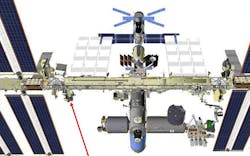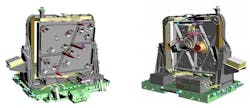Teledyne MUSES payload installed on ISS for precise Earth observation, imaging
THOUSAND OAKS, Calif. Astronauts installed and completed a successful initial operational assessment of the Multi-User System for Earth Sensing (MUSES), a precision-pointing environment for Earth-viewing instruments developed by Teledyne Brown Engineering, part of Teledyne Technologies Inc. (NYSE:TDY) in Thousand Oaks, California, on the International Space Station (ISS).
MUSES was developed as part of a cooperative agreement with NASA and will provide opportunities for imaging, technology demonstration, and space qualification payloads supporting research, scientific studies, and humanitarian efforts for government and commercial customers.
MUSES provides a precision-pointing environment for earth-viewing instruments, such as high-resolution digital cameras and hyperspectral imagers. It can accommodate up to four payloads simultaneously and offers the ability to change, upgrade, and service those instruments robotically.
Orbiting approximately 250 miles above the Earth, the MUSES platform will offer researchers a unique vantage point for Earth observation, disaster response, maritime domain awareness, agricultural applications, air and water quality, oil and gas exploration, mining, atmospheric investigations, and fire detection, officials say.
“The MUSES platform installation is a tremendous step toward the commercialization of the International Space Station. The ability to return payloads and reuse canisters creates a low-cost path to space for professional-grade payloads,” says Robert Mehrabian, chairman, president and chief executive officer of Teledyne Technologies. “We are proud to be a part of this mission and look forward to many more in the future.”
The MUSES platform is for both long-term operational instruments, and short-duration technology demonstrations including space hardware qualification. The unique ability to return payloads to earth allows for post-mission analysis and preservation of investment through reuse of instruments and payload canisters.
An on-board server located inside the ISS has the ability to buffer, store, and transmit data from MUSES’ four payloads back to Earth at Teledyne’s Payload Operation Center in Huntsville, Alabama. The server has the bandwidth to support four MUSES payloads as well as the interconnectivity and data resources to support other experiments aboard the ISS.
MUSES was launched to the ISS on a SpaceX Falcon 9 rocket from Launch Complex 39A at NASA’s Kennedy Space Center on 3 June 2017.
Teledyne Brown Engineering provides full-spectrum engineering and advanced manufacturing solutions for harsh environments for the space, defense, energy, and marine industries. For over six decades the company has successfully delivered innovative systems, integration, operations, and technology development worldwide.
Teledyne Technologies is a provider of sophisticated instrumentation, digital imaging products and software, aerospace and defense electronics, and engineered systems. Teledyne Technologies’ operations are primarily located in the United States, the United Kingdom, Canada, and Western and Northern Europe.
Search the Aerospace & Defense Buyer's Guide
The go-to resource for Intelligent Aerospace technology news & information:
Covering key topics
Across all market segments
Subscribe to the free Intelligent Inbox e-newsletter
Subscribe to receive all the latest aerospace technology news & information, delivered directly to your e-mail inbox twice a week (Tuesdays and Thursdays). Sign upfor your free subscription to the Intelligent Inbox e-newsletter at http://www.intelligent-aerospace.com/subscribe.html.
Connect on social media
Keep pace with aerospace innovation and opportunities via your favorite social media channels. Connect with Intelligent Aerospace on Twitter (@IntelligentAero), LinkedIn,Google+, and Instagram.

Courtney E. Howard | Chief Editor, Intelligent Aerospace
Courtney enjoys writing about all things high-tech in PennWell’s burgeoning Aerospace and Defense Group, which encompasses Intelligent Aerospace and Military & Aerospace Electronics. She’s also a self-proclaimed social-media maven, mil-aero nerd, and avid avionics and space geek. Connect with Courtney at [email protected], @coho on Twitter, on LinkedIn, and on Google+.




